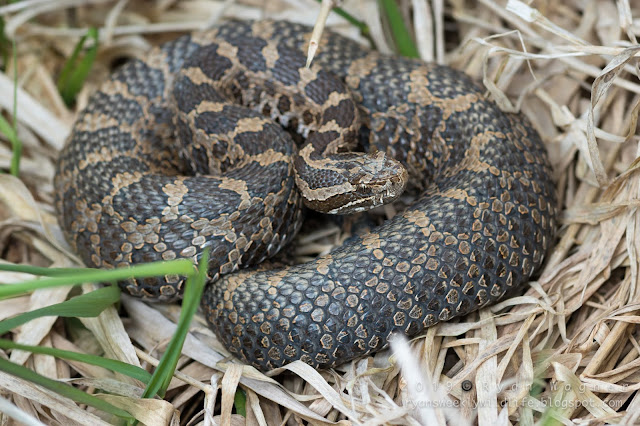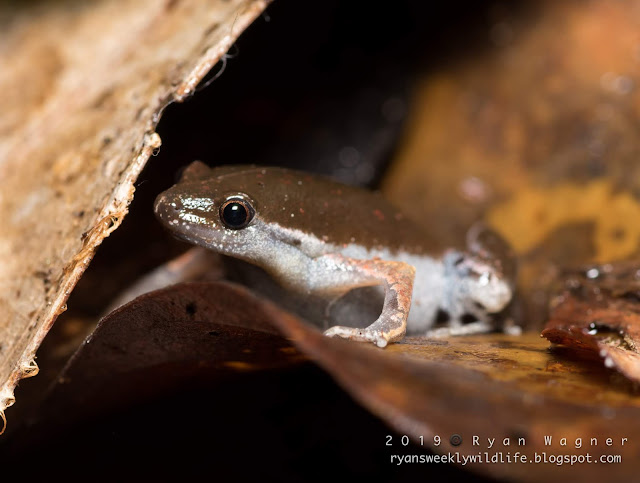It was overcast. Thinly veiled streaks of formless, gray-blue clouds stretched to the horizon. The rapidly warming day was quickly approaching the perfect basking conditions that I’d been waiting for all morning. I was feeling optimistic and energized. The spring semester had just finished and I’d soon be heading to New Hampshire for a position at the Hubbard Brook Experimental Forest in early June. That meant I had all of May at my leisure to pursue wildlife. I wasn't about to waste a single minute that could be spent birding or herping.
As I approached my destination, twenty five mph winds began to pick up. The bare branches of trees and newly-emerged roadside greenery swayed and creaked as I gripped my steering wheel to steady myself. Wind is generally not a friend to wildlife watchers. It keeps the birds away and the herps under cover. Old trees, aptly named “widow makers,” are of real concern. Luckily, I was headed to one of Ohio’s last remaining Prairie remnants in Northwestern Ohio where the sparse trees pose little danger. What I was there to look for, however, is another story entirely.
I parked along a gravel ditch just as a small tree shuddered and gave way across the street. The wind whipped across the open landscape, rustling through the grass as though hundreds of snakes were sliding all around me. I suddenly began to understand the overwhelming sense of dread that ophidiophobes must experience when encountering a snake. I strapped a pair of protective gaiters around each of my ankles. There could be a concealed rattlesnake below any tuft of grass, and I wouldn't be able to see it or hear it over the gales.
I’ve looked for Ohio’s two endangered rattlesnake species many times, but the smaller of the two has always eluded me. Eastern Massasauga Rattlesnakes (Sistrurus catenatus) inhabit the wet meadows, bogs, and mesic prairies from New York to Ontario and as far west as Iowa and Missouri. In Ohio, they were once considered commonplace across most of the glaciated half of the state. Direct persecution, habitat loss, collection, and road mortality have reduced their 28 county range down to just nine remaining counties. The eastern massasauga faces similar declines across eastern North America. These snakes were recognized as nationally imperiled in the 70s and are thought to be extirpated from 40% of their original localities.
Eastern Massasauga Rattlesnakes inhabit lowlands during the spring and fall, relying on crayfish burrows for cover and hibernation sites. Water just below the surface that never freezes is a must. If the frost layer penetrates the ground, the snakes will not survive. Loss of suitable overwintering habitat or modifications to the water table quickly decimates massasauga populations. Ohio alone has lost 90% of its original wetland habitat. These snakes persist in landscapes that pose particular difficulty to agriculture, and were subsequently left relatively unchanged.
Uplands are just as important to massasauga ecology. During the summer months, snakes move into upland forests to forage. These landscapes are often unprotected or heavily developed, resulting in population declines even when the adjacent wetlands are protected.
Uplands are just as important to massasauga ecology. During the summer months, snakes move into upland forests to forage. These landscapes are often unprotected or heavily developed, resulting in population declines even when the adjacent wetlands are protected.
With each step, water bubbled up through every crack and burrow in the mud. I hadn’t walked one hundred meters from my car when I froze. Sitting coiled in a tight bun atop an elevated pile of dry prairie grass was a massasauga rattlesnake. My heart raced as I took a few steps back and freed my camera from my pack. I crept around the motionless rattlesnake, it’s dark body burning into my retinas. Upon closer inspection, it became clear that this snake was not black, but tan with dark brown blotches; its triangular head and unblinking eyes were clearly visible through the tall grass. Stretched out, the sauga would probably measure over two feet (these pigmy rattlesnakes max out at just under three feet).
I kept a respectful distance, well outside of the snake’s strike range, but I still didn’t want to startle the sleeping viper. As I moved for a clearer shot of the head, the snake suddenly became aware of me. Striking or even rattling unless thoroughly provoked is almost unheard of. Massasaugas typically remain motionless, allowing the threat to pass by unawares. Perplexing, the massasauga twitched in agitation with an almost copperhead-style movement as it coiled its neck and raised its buzzing tail. I was shocked. I’ve encountered timber rattlesnakes at closer range and never had one so much as tongue flick. I stepped away, allowing the snake plenty of room to escape. Butt still buzzing, the sauga slipped below the tangles of grass and out of sight. I suddenly felt very glad I was wearing gaiters.
I am confident that this uncharacteristic encounter was down to individual personality. Carl Brune often tells the story of two eastern hog-nosed snakes he hatched from eggs. One sibling would play dead whenever approached, while the other would only flare its hood and hiss. Snakes are as much individuals as you or I.
During the course of my search, I encountered three more massasaugas. Two never budged as I watched and photographed them. The third was found out on the crawl, and while it did coil up upon my approach, it never rattled or gave the faintest impression that it felt threatened. After a few minutes, it slowly turned away and drifted off into the tall grass.
After that first encounter, I was primed to be a bit jumpy. I was scared half to death when a snake came lunging out of the tall grass in full strike, mouth agape. After the initial shock wore off, I looked down to see a large, but utterly harmless, eastern gartersnake. “What are you doing??” I said aloud, holding back laughter. I plucked the grumpy garter from the grass and placed him off the trail. Snakes, venomous and nonvenomous alike, have no interest in biting if they don’t have to. All they want is to be out of harm's way. Sadly, senseless killing by ignorant or fearful snake-haters continues. It is not unheard of to discover a dead sauga with its rattle cut off—as a trophy.
Even where massasauga populations appear stable, a new threat has emerged on the scene. In 2006, a fungal pathogen called Ophidiomyces ophiodiicola was discovered in Timber rattlesnakes. This fungus targets wild and captive snakes, primarily rattlers and colubrids, in eastern North America and Europe. It penetrates the epidermis though any small wound and causes lesions and blisters to form across the snake's head and body. The origin and dispersal mechanism of this fungus are unknown, but it can survive in the environment without a host for some time. Whether this fungus was introduced or a native turned virulent, it appears to work in tandem with other environment stressors like habitat modification and climate change. Some snakes may be able to shed repeatedly to keep the fungus at bay, but many succumb as the infection attacks the deeper layers of skin, muscle, and bone. Massasaugas are particularly vulnerable to this Snake Fungal Disease, and their already dwindling populations are being pushed closer toward extirpation by its spread.
I've visited many historical localities where the tufts of wiregrass and crayfish burrows no longer harbor wild massasaugas due to poaching and habitat modification. Without their swamp rattlers, these wet meadows, fens, bogs, and prairies feel eerily empty. It would be an irreparable shame to see the littlest of Ohio's vipers disappear from its final strongholds.
Thanks for reading!
Keep living the field life.
Ryan
I've visited many historical localities where the tufts of wiregrass and crayfish burrows no longer harbor wild massasaugas due to poaching and habitat modification. Without their swamp rattlers, these wet meadows, fens, bogs, and prairies feel eerily empty. It would be an irreparable shame to see the littlest of Ohio's vipers disappear from its final strongholds.
Thanks for reading!
Keep living the field life.
Ryan































